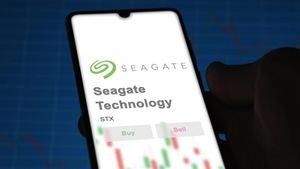
US private sector employment saw a stronger-than-expected rebound in October 2025, with payrolls increasing by 42,000 jobs. This unexpected surge, reported by the ADP National Employment Report, comes after two consecutive months of declines, sending a mixed signal to a labor market grappling with a "stalled" environment and an ongoing government shutdown. The data has immediately injected a new layer of complexity into the Federal Reserve's monetary policy calculus, potentially challenging recent dovish shifts and sparking fresh debate over the trajectory of interest rates.
The robust payroll figures, which significantly exceeded economists' forecasts ranging from 25,000 to 32,000 jobs, suggest a surprising underlying resilience in certain segments of the US economy. While offering a glimmer of hope amidst broader economic headwinds, this unexpected strength could temper expectations for further aggressive interest rate cuts, as the central bank weighs its dual mandate of maximum employment and price stability against persistent inflationary pressures.
A Deeper Dive into October's Employment Rebound
October's private payroll increase of 42,000 marks the first monthly gain since July, according to the ADP National Employment Report. This figure stands in contrast to September's revised loss of 29,000 jobs, which was an improvement from the initially reported decline of 32,000. Annual pay growth for private sector employees remained stable, up 4.5% year-over-year, suggesting that while hiring is picking up, wage pressures are not accelerating dramatically. The timing of this report is particularly crucial given the ongoing government shutdown, which has delayed the release of official employment data from the Bureau of Labor Statistics (BLS), making the ADP data a more timely, albeit partial, indicator of labor market health.
The job growth, however, was not uniformly distributed across all sectors. The primary engines of job creation were concentrated in education and health care, alongside trade, transportation, and utilities. Conversely, several key sectors continued to shed jobs for the third consecutive month, including professional business services, information, and leisure and hospitality. The goods-producing sector added 9,000 jobs, primarily driven by natural resources/mining and construction, while manufacturing experienced a decline of 3,000 jobs, highlighting a divergent performance within the industrial landscape.
Initial market reactions have been nuanced. While the stronger data could be interpreted positively as a sign of economic resilience, it has also led to a slight decline in the probability of an additional 25-basis-point rate cut by the Federal Reserve in December. This shift reflects concerns that a more robust labor market might embolden the Fed to maintain a more hawkish stance, especially if it perceives that inflation risks persist. The ongoing government shutdown and tariff-fueled inflation continue to cast a shadow, acting as significant headwinds that could dampen the overall economic impact of this positive employment report.
Corporate Winners and Losers in a Resilient Labor Market
The surprising strength in October's private payrolls data, combined with stable wage growth and the Federal Reserve's potentially less dovish stance, creates a bifurcated landscape for public companies. Sectors closely tied to consumer spending and those benefiting from a "higher for longer" interest rate environment are poised to gain, while interest-rate sensitive industries and highly leveraged firms may face continued headwinds.
Companies in the Consumer Discretionary sector are likely to be among the primary beneficiaries. A robust job market with steady income growth typically translates into increased consumer confidence and greater disposable income. This fuels spending on non-essential goods and services, benefiting major retailers such as TJX Companies (NYSE: TJX) and Costco Wholesale Corporation (NASDAQ: COST), as well as appliance manufacturers like Whirlpool Corporation (NYSE: WHR). E-commerce giants like Amazon.com, Inc. (NASDAQ: AMZN) and apparel and footwear leaders like Nike, Inc. (NYSE: NKE) could also see a positive impact from a more willing consumer base, though their broad market exposure means they are also sensitive to broader economic anxieties.
The Staffing Services industry is another clear winner. Strong private payrolls directly indicate a healthy demand for labor, which is the core business of staffing and recruiting agencies. As companies across various industries continue to seek talent, firms like Heidrick & Struggles International, Inc. (NASDAQ: HSII), TrueBlue, Inc. (NYSE: TBI), and RCM Technologies, Inc. (NASDAQ: RCMT) are likely to experience increased placement volumes and revenues. This sustained hiring activity provides a solid foundation for their business models.
Conversely, the Financial Services sector presents a mixed but generally favorable outlook, particularly for banks. A scenario where the Federal Reserve is less inclined to cut rates means interest rates could remain elevated or decline more slowly than anticipated. This environment typically leads to wider net interest margins (NIM) for banks, boosting profitability as they earn more on loans than they pay on deposits. Large banking institutions such as Bank of America Corporation (NYSE: BAC) and JPMorgan Chase & Co. (NYSE: JPM), with their substantial lending operations, are well-positioned to benefit. Firms with significant trading operations like The Goldman Sachs Group, Inc. (NYSE: GS) could also see increased activity in a more stable, albeit higher-rate, economic climate.
On the other side of the ledger, Interest-Rate Sensitive Industries are likely to continue facing challenges. The Real Estate sector, including homebuilders and real estate investment trusts (REITs), will contend with higher mortgage rates that can dampen demand for new homes and commercial properties, increasing borrowing costs for developers. Mortgage companies, in particular, may see reduced loan applications and even layoffs. Similarly, capital-intensive Utilities that rely heavily on debt financing for infrastructure projects will find their profitability and expansion plans squeezed by elevated borrowing costs. Furthermore, any Highly Leveraged Companies across various sectors will face increased interest expenses, eroding profit margins and potentially hindering growth investments.
The Technology Sector, especially growth-oriented companies, might also experience headwinds. While a strong economy can drive demand for tech products, higher interest rates tend to depress valuations for companies whose value is heavily reliant on future earnings potential, as these future earnings are discounted more steeply. Startups and capital-intensive tech firms that depend on external funding for research and development will face higher borrowing costs, potentially slowing innovation and expansion. While cash-rich tech giants like Apple Inc. (NASDAQ: AAPL) or Microsoft Corporation (NASDAQ: MSFT) may be more resilient, the sector as a whole could see its performance moderated if higher borrowing costs outweigh the domestic employment strength.
Broader Implications: Navigating a Resilient Yet Complex Economic Landscape
The stronger-than-expected US private payrolls data for October 2025 fits into a broader economic narrative characterized by surprising resilience but persistent complexities, particularly concerning inflation and the Federal Reserve's policy path. This report reinforces the notion that the US economy continues to defy expectations of a significant slowdown, even as it navigates structural shifts and global headwinds.
In terms of broader economic trends, the data presents a nuanced picture for inflation and labor market tightness. While robust employment growth typically fuels consumer spending and can contribute to inflationary pressures, the annual pay growth of 4.5% has remained relatively stable for over a year, suggesting that wage gains are moderating. This indicates that the labor market, while strong, may not be as acutely tight as it was in 2022. However, with headline Consumer Price Index (CPI) inflation at 3.0% in September 2025, still above the Federal Reserve's 2% target, any signs of economic strength that could reignite demand-side inflation will be closely scrutinized. The overall strong job growth supports a narrative of continued economic expansion, with the US economy demonstrating remarkable resilience and outperforming many other G7 nations since the pandemic.
The ripple effects on competitors and partners are significant. A robust US economy, driven by strong domestic demand, generally translates into higher imports, benefiting global trade partners. However, the potential for the Federal Reserve to maintain higher interest rates or delay cuts, in response to this strength, could lead to a stronger US dollar. A stronger dollar makes US exports more expensive but imports cheaper, impacting global trade balances. For countries with dollar-denominated debt, a strengthening dollar increases their repayment burden, potentially hindering their economic growth. Furthermore, the US economy's outperformance, fueled by innovation in sectors like AI and a dynamic investment culture, poses competitive challenges for other advanced economies, particularly in Europe and Japan, which often struggle with lower productivity and less agile innovation ecosystems.
For the Federal Reserve, the October payrolls data significantly complicates its monetary policy decisions. Operating under a dual mandate of maximum employment and price stability, the Fed recently implemented a quarter-point rate cut in October 2025, bringing the target range to 3.75%-4%. However, persistently strong job growth challenges the rationale for further aggressive rate reductions, as it could signal enduring inflationary pressures. There are "strongly differing views" within the Federal Open Market Committee (FOMC), with some advocating for more aggressive cuts despite strong employment, while others prioritize combating inflation. This strong data could temper market expectations for a December rate cut, making it "not a foregone conclusion." The ongoing government shutdown, which has delayed official BLS data, also forces policymakers to rely more heavily on private reports like ADP, adding a layer of uncertainty to their assessments.
Historically, there are precedents for the Fed navigating strong employment figures amidst inflationary concerns. During the early 1980s, the Federal Reserve, under Chairman Paul Volcker, aggressively raised interest rates to combat rampant inflation, even as nonfarm employment grew. This aggressive tightening successfully brought down inflation but also contributed to a recession. More recently, following the COVID-19 pandemic, the Fed aggressively hiked rates from March 2022 to July 2023 to combat surging inflation, despite a robust labor market. These historical comparisons underscore the Fed's commitment to price stability, even if it means potentially sacrificing some employment growth in the short term, highlighting the delicate balancing act required of monetary policymakers.
The Road Ahead: Navigating Uncertainty and Opportunity
The unexpected strength in October's US private payrolls data sets the stage for a period of heightened scrutiny and potential volatility, as the market and policymakers grapple with its implications for the economy's trajectory and the Federal Reserve's next moves. Both short-term reactions and long-term strategic adjustments will be crucial for businesses and investors.
In the short term, the robust payroll figures suggest continued economic activity and consumer spending, potentially bolstering confidence. However, this resilience also complicates the Federal Reserve's inflation fight, which remains above its 2% target. The immediate possibility is a diminished expectation for further aggressive rate cuts, leading to a "higher for longer" interest rate environment. This could strengthen the US dollar, making imports cheaper but exports more expensive. For investors, this might mean a rotation towards sectors that thrive in a stable, higher-rate environment, such as certain financial institutions and consumer discretionary stocks, while re-evaluating highly leveraged companies or growth stocks sensitive to discount rates.
Looking long term, a persistently strong labor market, if balanced by productivity gains, can support sustained economic expansion. The US economy is projected to continue growing in 2025 and 2026, driven by consumer spending and AI-related business investment. However, the underlying tightness in the labor market, characterized by more job openings than available workers due to demographic shifts, poses a long-term challenge. Businesses will need to make strategic pivots, focusing on upskilling and reskilling their workforce, enhancing employer branding, and accelerating the adoption of automation and AI to boost productivity and offset labor shortages. Investors, meanwhile, should consider sector rotation, inflation hedges, and close monitoring of Fed signals for shifts in monetary policy.
Market opportunities may emerge from continued economic growth, robust consumer spending, and the ongoing boom in AI and high-tech investments. Companies that can leverage technology to increase productivity in a tight labor market will likely thrive. However, significant challenges persist, primarily the risk of exacerbated inflationary pressures, which could force the Fed to maintain higher rates or even consider tightening, potentially dampening economic activity. Businesses will continue to face the challenge of rising labor costs if wage growth outpaces productivity. The current government shutdown, delaying official statistics, also adds to market uncertainty and complicates forecasting.
Several potential scenarios could unfold for the US economy and Federal Reserve policy. The most prominent is the "higher for longer" interest rate environment, where strong job growth compels the Fed to maintain current rates or delay cuts to curb inflation, impacting interest-rate-sensitive sectors. While a "soft landing" remains a possibility—a gradual economic slowdown without a severe recession—strong payrolls make this more challenging as it implies continued demand. A less favorable scenario involves "stagflationary concerns," where persistent inflation coexists with stagnant real wage growth, posing significant challenges across most asset classes. Ultimately, the stronger ADP data will intensify debate within the FOMC, leading to potential market volatility as expectations for future rate cuts become less certain.
Conclusion: A Delicate Balance and Vigilant Outlook
The October 2025 US private payrolls data, reporting a stronger-than-expected gain of 42,000 jobs, serves as a critical, albeit partial, barometer of the US labor market's health amidst an ongoing government shutdown. While the figures suggest a modest rebound and underlying resilience, they also underscore a complex economic environment characterized by a "low hire, low fire" mentality among employers and persistent inflationary pressures. This delicate balance will continue to shape market dynamics and Federal Reserve policy in the months ahead.
Key takeaways from the ADP report include the surprising increase in private employment after two months of declines, exceeding market expectations. However, this growth was not uniform, with large businesses driving job creation while small and mid-sized companies shed positions. Sectors like education and health services, along with trade, transportation, and utilities, saw gains, while professional business services, information, and leisure and hospitality continued to contract. Annual pay growth remained stable, suggesting that while the labor market is not collapsing, it's also not experiencing the acute tightness seen in earlier periods.
Moving forward, the market will likely interpret this data as a signal that the labor market is stabilizing rather than entering a significant downturn, potentially alleviating immediate recession fears. However, this stability, combined with inflation still above the Fed's target, tempers expectations for aggressive interest rate cuts, leading to a "higher for longer" narrative for borrowing costs. This scenario has already led to a strengthening US dollar and could continue to influence capital flows and asset valuations. The Federal Reserve remains caught in a "key tension" between a potentially slowing labor market and sticky inflation, ensuring continued market volatility as policymakers navigate their dual mandate.
The lasting impact of this report hinges on its interpretation by the Federal Reserve and subsequent economic data. If the "low hire, low fire" trend persists alongside elevated inflation, the Fed's path forward will be challenging, prolonging uncertainty regarding interest rates and potentially impacting economic growth. Structural shifts, such as increased automation and decelerating labor force growth due to demographics, will also continue to shape the long-term employment landscape.
Investors should vigilantly watch for several key indicators in the coming months. The eventual release of official Nonfarm Payrolls and unemployment rate data from the Bureau of Labor Statistics will be paramount, as any divergence from the ADP figures could trigger significant market adjustments. Continued monitoring of inflation trends, particularly the CPI and PCE price index, is crucial, as these will heavily influence the Fed's policy decisions. Close attention should also be paid to statements and speeches from Federal Reserve officials for clues on their economic outlook and future interest rate policy. Furthermore, alternative labor market indicators, the resolution and impact of the government shutdown, and broader geopolitical and trade developments will all play a role in shaping market sentiment and investment strategies.
This content is intended for informational purposes only and is not financial advice








